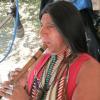 Submitted by Joseph Morningstar on
Submitted by Joseph Morningstar on

Ghost sickness is a cultural belief among some traditional Indigenous peoples in North America, notably the Navajo, and some Muscogee and Plains cultures. People who are preoccupied and/or consumed by the deceased are believed to suffer from ghost sickness. Reported symptoms can include general weakness, loss of appetite, suffocation feelings, recurring nightmares, and a pervasive feeling of terror. The sickness is attributed to ghosts (Navajo: chʼį́įdii) or, occasionally, to witches or witchcraft. Children are thought to be especially at risk of being affected because they are not as attached to their new bodies.
Chindi is a general term for ghost. Many Navaho groups believed that if a person did not receive the correct burial rites upon death, he would be bound to the earth and cause Ghost Sickness. The Navaho idea of ghost sickness included feeling tired, having fever, and being sick to the stomach. The Chindi could only be laid to rest by performing correct funeral rites. *
In the Muscogee (Creek) culture, it is believed that everyone is a part of an energy called Ibofanga. This energy supposedly results from the flow between mind, body, and spirit. Illness can result from this flow being disrupted. Therefore, their "medicine is used to prevent or treat an obstruction and restore the peaceful flow of energy within a person". Purification rituals for mourning "focus on preventing unnatural or prolonged emotional and physical drain."
The grief resolution processes for traditional Native Americans are qualitatively different than those usually seen in mainstream Western cultures. In 1881, there was a federal ban on some of the traditional mourning rituals practiced by the Lakota and other tribes. Lakota expert Maria Yellow Horse Brave Heart proposes that the loss of these rituals may have caused the Lakota to be "further predisposed to the development of pathological grief". Some manifestations of unresolved grief include seeking visions of the spirits of deceased relatives, obsessive reminiscing about the deceased, longing for and believing in a reunion with the deceased, fantasies of reappearance of the deceased, and belief in one's ability to project oneself to the past or to the future.
According to Amber Hauck:
**The biological features of this disease are mostly psychological. The afflicted person is at obsessed with death or a deceased person whom they believe is causing their affliction. They have nightmares and other sleep disturbances, anxiety, a sense of danger, hallucinations, and confusion. Other biological symptoms include weakness and fatigue, lowered appetite and other digestion problems, dizziness, fainting, and even loss of consciousness. In some cases, there is a great feeling of depression as well.
Native American culture has a world-view that is cyclical rather than a cause-and-effect worldview. What this means is that all events affect each other, regardless of when the event occurs; past, present, or even future. Considering this cultural world-view, ghost sickness can be better understood. By not practicing proper burial and mourning rituals, the deceased cannot be at peace in their new spiritual plane. Consequently, the deceased causes physical and mental problems for the living. Then, this person suffering from ghost sickness does not practice more rituals, subsequently causing the inability for the deceased to be at peace.
Individual aspects of the disease are incredibly important here. First, the sufferer is obsessed with death or a certain deceased person. This may be a person of kin who recently passed, a mate, or even a lost ancestor. It is said that many Native Americans who suffer from Ghost Sickness are actually suffering from a complicated grieving process. The sufferer begins to have nightmares and dreams, then later feel queasy and the physical and psychological symptoms set in. In some aspect this person must also be somewhat susceptible to depression as well. The person must also believe in the dead and their voices in order to be afflicted by Ghost Sickness.
The only known treatment for Ghost Sickness is rituals that are performed by the Navajo tribe members. The religious leaders will perform rituals to eliminate the all-consuming thoughts of the dead. Other treatments may include anti-depressants or anti-anxiety medicines, but this only occurs if the patient is brought to a doctor in Western medicine.
*** It is believed that there are a few ways to treat ghost sickness in the Native American culture. These methods involve tricking spirits. One way is to remove a body through a hole in the wall of a house. The logic behind this is that the spirit cannot return to the house the same way that it left. A trick to prevent this issue all together is to dress children up as adults when they attend funerals. Since they are the most effected, it is wise to try to preventative with them. A Shaman can also put an end to this issue by venturing into the spirit world to retrieve the ill person’s soul. The reality is that these symptoms can be related to issues like depression that could be treated in western culture with therapy. It is also possible that children are the most affected because their immune systems are not fully developed so they can be effected by a pathogen more than a grown adult.
Resources:
https://en.wikipedia.org/wiki/Ghost_sickness
*Leddon, Alan, A Child’s Eye View of Ghosts and Hauntings, pg. 37
** http://anthropology.msu.edu/anp204-us13/2013/07/20/ghost-sickness-among-native-americans/
*** http://anthropology.msu.edu/anp204-us15/2015/06/05/w3-activity-ghost-sickness/